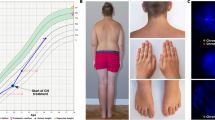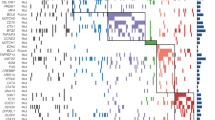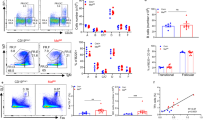Abstract
One of the most extensively studied X-linked immunodeficiency disorder is the xid mutation of the mouse strain CBA/N (reviewed in ref. 1). This mutation may involve a maturational defect as xid animals are unable to raise antibodies to soluble polysaccharide antigens, a function normally attributed to late-stage B cells2,3. Moreover, studies using monoclonal antibodies have defined a B-cell surface antigen (BLA-2 or 14G8) that is expressed on most or all immature B lymphocytes, but not on a subpopulation of mature splenic B lymphocytes4,5; this late-stage, 14G8 antigen-negative splenic B-cell subpopulation is apparently absent from mice bearing the xid defect5. In the accompanying paper6 we describe the isolation of a cDNA clone recognizing a family of genes on the X chromosome, at least some of whose members are closely linked to the xid trait. We report here that this gene family, XLR, is transcribed in certain B- and T-cell lineage tumours, but not in macrophage tumours, or liver or kidney cells. We show that it is transcribed principally in late-stage, 14G8-negative B-cell tumours and plasmacytomas, but not in immature B-cell or pre-B-cell tumours. We are able to detect transcription in all of 12 plasmacytomas (secretory B-cell tumours) derived from mice with normal X chromosomes, but not in three plasmacytomas carrying the xid mutation. These data, combined with the restriction fragment length polymorphism analysis linking the XLR gene family to the xid mutation6, suggests that the xid defect occurs within a member of this gene family.
This is a preview of subscription content, access via your institution
Access options
Subscribe to this journal
Receive 51 print issues and online access
$199.00 per year
only $3.90 per issue
Buy this article
- Purchase on SpringerLink
- Instant access to full article PDF
Prices may be subject to local taxes which are calculated during checkout
Similar content being viewed by others
References
Paul, W. E. et al. in Cells of Immunoglobulin Synthesis, 383–396 (Academic, New York, 1979).
Ahmed, A. et al.. J. exp. Med. 145, 101–110 (1977).
Mosier, D. E. et al. Immun. Rev. 37, 89–104 (1977).
Kung, J. T. et al. J. Immun. 128, 2049–2056 (1982).
Hardy, R. R., Hayakawa, K., Parks, D. R., Herzenberg, L. A. & Herzenberg, L. A. J. exp. Med. 159, 1169–1188 (1984).
Cohen, D. I. et al. Nature 314, 369–372 (1985).
Lachman, L. B., Hacker, M. P., Blyden, G. T. & Handschumacher, R. E. Cell. Immun. 34, 416–418 (1977).
Mizel, S. B., Rosenstreich, D. L. & Oppenheim, J. J. Cell. Immun. 40, 230–241 (1978).
Howard, M. et al. J. exp. Med. 155, 914–923 (1982).
Kemp, D. J., Harris, A. W., Cory, S. & Adams, J. M. Proc. natn. Acad. Sci. U.S.A. 77, 2876–2880 (1980).
Lewin, B. in Gene Expression Vol. 2, 2nd edn, 713–719 (Wiley, New York, 1980).
Hedrick, S. M., Cohen, D. I., Nielsen, E. A. & Davis, M. M. Nature 308, 149–153 (1984).
Davis, M. M., Chien, Y. H., Gascoigne, N. R. J. & Hedrick, S. M. Immun. Rev. 81, 235–258 (1984).
Payne, G. S., Bishop, J. M. & Varmus, H. E. Nature 295, 209–217 (1982).
Mather, E. L., Alt, F. W., Bothwell, A. L. M., Baltimore, D. & Koshland, M. E. Cell 23, 369–389 (1981).
Siden, E. J., Baltimore, D., Clark, D. & Rosenberg, N. Cell 16, 389–396 (1979).
Levitt, D. & Cooper, M. D. Cell 19, 617–625 (1980).
Scher, I., Sharrow, S. O., Wistar, R. Jr, Asofsky, R. & Paul, W. E. J. exp. Med. 144, 494–506 (1976).
Kearney, J. F. et al. J. exp. Med. 146, 297–301 (1977).
Koshland, M. E. Adv. Immun. 20, 41–69 (1975).
Yagi, M. & Koshland, M. E. Proc. natn. Acad. Sci. U.S.A. 78, 4907–4911 (1981).
Rogers, J. et al. Cell 20, 303–312 (1980).
Steinberg, B. J. et al. J. clin. Invest. 70, 587–597 (1982).
Klein, J. in Biology of the Mouse Histocompatibility Complex, 16–39 (Springer, New York, 1975).
Perlmutter, R. M. et al. J. exp. Med. 149, 993–998 (1979).
Kim, K. J. et al. J. Immun. 122, 549–554 (1979).
Lanier, L. L., Warner, N. L., Ledbetter, J. A. & Herzenberg, L. A. J. Immun. 127, 1691–1697 (1981).
Slavin, S. & Strober, S. Nature 272, 624–626 (1978).
Gebel, H. M., Autry, J. R., Rohrer, J. W. & Lynch, R. G. J. natn. Cancer Inst. 62, 201–212 (1979).
Alwine, J. C., Kemp, D. J. & Stark, G. R. Proc. natn. Acad. Sci U.S.A. 74, 5350–5354 (1977).
Parnes, J. R. et al. Proc. natn. Acad. Sci. U.S.A. 78, 2253–2257 (1981).
Seed, B. in Genetic Engineering Vol.4 (eds Setlow, J. K. & Hollaender, A.) 91–102 (Academic, New York, 1982).
Author information
Authors and Affiliations
Rights and permissions
About this article
Cite this article
Cohen, D., Steinberg, A., Paul, W. et al. Expression of an X-linked gene family (XLR) in late-stage B cells and its alteration by the xid mutation. Nature 314, 372–374 (1985). https://doi.org/10.1038/314372a0
Received:
Accepted:
Issue date:
DOI: https://doi.org/10.1038/314372a0
This article is cited by
-
A putative human equivalent of the murine Xlr (X-linked, lymphocyte-regulated) protein
Mammalian Genome (1995)
-
068 Isolation of a possible human counterpart to the murine XLR genes
Fresenius' Journal of Analytical Chemistry (1992)
-
Mechanisms of rhysiologic B cell responses and B cell hyperactivity in systemic lupus erythematosus
Springer Seminars in Immunopathology (1986)
-
Isolation of a cDNA clone corresponding to an X-linked gene family (XLR) closely linked to the murine immunodeficiency disorder xid
Nature (1985)
-
Immunogenetics: Lymphocyte development genes and immunodeficiency disease
Nature (1985)



